
Hacettepe Journal of Mathematics and Statistics
Scope & Guideline
Cultivating a Collaborative Community of Mathematicians
Introduction
Aims and Scopes
- Statistical Theory and Methodology:
The journal focuses on statistical theory, including the development of new methodologies for data analysis, hypothesis testing, and estimation techniques across various contexts. - Mathematical Modeling and Applications:
Research that involves the application of mathematical concepts to real-world problems, particularly in fields such as engineering, physics, and finance, is a core area of interest. - Analysis and Functional Analysis:
This includes the study of various mathematical analyses, including functional analysis, operator theory, and their applications in solving differential equations and optimization problems. - Algebraic Structures and Combinatorial Mathematics:
The journal publishes work on algebraic structures, including rings, modules, and group theory, and explores combinatorial mathematics, which underpins many areas of discrete mathematics. - Geometry and Topology:
Research exploring geometric properties of spaces and topological structures, particularly in relation to mathematical physics and applied mathematics. - Computational Mathematics:
The journal emphasizes computational methods and numerical analysis, focusing on algorithms and their applications in solving complex mathematical problems.
Trending and Emerging
- Bayesian Statistics and Machine Learning:
There is a growing emphasis on Bayesian methods and machine learning applications, driven by the need for advanced techniques in data analysis and inference in complex models. - Data Science and Big Data Analytics:
As the field of data science expands, the journal is increasingly featuring research focused on methodologies for big data analysis, including new statistical techniques and computational algorithms. - Nonlinear Dynamics and Chaos Theory:
Research exploring nonlinear systems and chaotic behavior is gaining traction, reflecting a broader interest in understanding complex systems in both mathematical and applied contexts. - Network Theory and Graph Analysis:
The study of networks, particularly in relation to social networks, biological systems, and complex systems, is an emerging theme, highlighting the interdisciplinary nature of modern research. - Stochastic Processes and Applications:
There is a rising trend in the exploration of stochastic processes, particularly in applications to finance, insurance, and risk management, recognizing the importance of uncertainty in modeling.
Declining or Waning
- Classical Statistical Models:
There has been a noticeable reduction in papers focusing on traditional statistical models, as researchers increasingly favor more complex and robust methodologies that address modern data challenges. - Elementary Number Theory:
While still a foundational area, publications specifically concentrating on elementary number theory have decreased, possibly due to the rise of more applied and computational approaches to number theory. - Basic Probability Theory:
Interest in basic probability theory as a standalone topic has waned, with a shift towards more advanced topics such as stochastic processes and probabilistic modeling in complex systems. - Deterministic Mathematical Models:
Research on purely deterministic models, particularly in applied mathematics, has seen a decline as stochastic models gain traction in addressing uncertainty in real-world applications. - Classical Geometry:
Papers focusing solely on classical geometry concepts without application to modern contexts have become less common, as the field evolves to incorporate more practical and computational aspects.
Similar Journals

Matematiche
Cultivating Knowledge in the Heart of MathematicsMatematiche is a prestigious open access journal published by the Department of Mathematics at the University of Catania, Italy. Established in 1986, this journal has become a vital resource for scholars interested in the fields of Applied Mathematics, Information Systems, and various branches of Mathematics (miscellaneous). With its recent classification in the Q3 quartile across these categories, it serves as a platform for progressive research and innovative applications relevant to mathematicians and computer scientists alike. Although it currently exhibits a low H-index and percentile rankings within Scopus, Matematiche provides a collaborative forum for the dissemination of cutting-edge mathematical findings. Accessible to both established researchers and emerging scholars, the journal encourages a diverse range of contributions that push the boundaries of mathematical science. The journal is committed to openness and knowledge-sharing, making it an essential asset for anyone seeking to advance their understanding of mathematics in both theoretical and applied contexts.
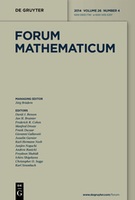
FORUM MATHEMATICUM
Unraveling Complexities: Where Mathematics Meets InsightFORUM MATHEMATICUM, published by WALTER DE GRUYTER GMBH, is a distinguished academic journal based in Germany, known for its significant contributions to the field of mathematics. With an ISSN of 0933-7741 and an E-ISSN of 1435-5337, the journal features comprehensive studies ranging from applied mathematics to diverse mathematical disciplines. Having maintained a commendable presence since 1989, FORUM MATHEMATICUM has achieved notable classification rankings, including Q2 in Applied Mathematics and Q1 in miscellaneous Mathematics as of 2023. Additionally, it holds a Scopus rank within the top 60th percentile in General Mathematics, making it a prominent platform for researchers and professionals seeking rigorous analysis and innovative methodologies in mathematics. While the journal does not currently offer open access, its rich content is pivotal for advancing mathematical theory and applications, appealing to students and seasoned academics alike.
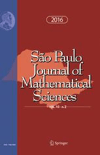
Sao Paulo Journal of Mathematical Sciences
Advancing mathematical innovation, one article at a time.Welcome to the Sao Paulo Journal of Mathematical Sciences, a pivotal platform dedicated to advancing the field of mathematics, published by Springer International Publishing AG. Established in 2015 and running until 2024, this journal serves as a vital resource for researchers, professionals, and students interested in a plethora of mathematical topics, including computational theory, statistics, and general mathematics. While the journal holds a current Q4 quartile ranking in its categories, it provides an opportunity for contributors to disseminate innovative findings in an accessible manner. Although not an open-access publication, the journal is committed to ensuring that high-quality research is available to the academic community, fostering collaboration and growth within the discipline. Researchers seeking to publish in a dynamic and developing journal should consider the Sao Paulo Journal of Mathematical Sciences as an essential avenue for their work.

Revista de la Real Academia de Ciencias Exactas Fisicas y Naturales Serie A-Matematicas
Advancing Mathematical Frontiers with ExcellenceRevista de la Real Academia de Ciencias Exactas Fisicas y Naturales Serie A-Matematicas, published by SPRINGER-VERLAG ITALIA SRL, is a premier academic journal based in Italy that serves as a significant platform for researchers and practitioners in the fields of Mathematics. With a focus on core areas such as Algebra, Analysis, Applied Mathematics, Computational Mathematics, and Geometry and Topology, this journal boasts an impressive performance in academic rankings, achieving Q1 status in multiple categories, reflecting its excellence in disseminating high-quality research. The journal is easily accessible through subscription options and provides a vital resource for the mathematics community, fostering the exploration of innovative ideas and methodologies. The journal’s commitment to advancing mathematical knowledge is evident through its competitive Scopus rankings, including a remarkable rank of #1 in Algebra and Number Theory, placing it in the top percentile of its field. Scholars and students alike will find in this publication a rich source of impactful research that not only contributes to the academic discourse but also enhances the practical applications of mathematics in today's society.
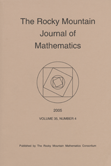
ROCKY MOUNTAIN JOURNAL OF MATHEMATICS
Exploring the Depths of Mathematical InnovationROCKY MOUNTAIN JOURNAL OF MATHEMATICS, published by the Rocky Mountain Math Consortium, serves as a critical platform for researchers and practitioners in the field of mathematics since its inception in 1971. With a notable presence in the academic community, this journal covers a broad spectrum of mathematical disciplines, positioning itself in the Q2 category for Mathematics (miscellaneous) as of 2023. Despite being a subscription-based journal, it is recognized for its rigorous peer-review process and contributions to theoretical and applied mathematics, helping to advance knowledge and foster collaboration among mathematicians. The journal's ISSN number is 0035-7596 and its E-ISSN is 1945-3795, reflecting its commitment to accessibility and dissemination of high-quality research. Based in Tempe, Arizona, at Arizona State University, the journal continues to play an important role in shaping contemporary mathematical discourse through well-researched articles and innovative studies, aiming to bridge gaps between various mathematical subfields and engage a diverse audience, including students and established researchers alike.

Forum of Mathematics Pi
Pioneering New Horizons in Mathematical ResearchForum of Mathematics Pi, published by Cambridge University Press, stands at the forefront of mathematical research, providing an open-access platform since 2013. With an ISSN of 2050-5086, this journal has rapidly established itself within the mathematical community, particularly noted for its high impact in the realms of Algebra and Number Theory, Analysis, Discrete Mathematics and Combinatorics, Geometry and Topology, Mathematical Physics, and Statistics and Probability, as evidenced by its 2023 Q1 rankings across these categories. Its placement within the top quartile signifies its importance and influence, attracting submissions from leading researchers and academicians around the globe. The journal’s diverse scope and rigorous peer-review process ensure a high standard of scholarly excellence, making it an indispensable resource for professionals, students, and researchers eager to stay informed about cutting-edge mathematical advancements. Access to its comprehensive array of articles is openly available, promoting a culture of collaboration and knowledge sharing in the mathematics community.
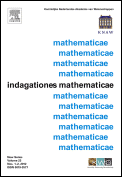
INDAGATIONES MATHEMATICAE-NEW SERIES
Unveiling insights that shape the future of mathematics.INDAGATIONES MATHEMATICAE-NEW SERIES is a distinguished academic journal specializing in the field of mathematics, with a focus on both theoretical and applied aspects of the discipline. Published by Elsevier, a leading publisher in the scientific community, this journal has established itself as a crucial platform for the dissemination of high-quality research. With an ISSN of 0019-3577 and an E-ISSN of 1872-6100, it operates out of the Netherlands and has been a vital resource for academics since its inception in 1969. Currently, it holds a Q2 ranking in the mathematics category, signifying its relevance and impact in the field, with a Scopus rank of #222 out of 399 in General Mathematics, placing it in the 44th percentile. Although it does not currently offer Open Access options, INDAGATIONES MATHEMATICAE-NEW SERIES is committed to contributing to the advancement of mathematics by publishing original research articles, reviews, and notes that enrich the academic community. Researchers, students, and professionals alike will find invaluable insights and developments within its pages, making it a cornerstone journal for those keen on exploring the complexities of mathematics.

European Journal of Mathematics
Connecting Researchers to Emerging TrendsWelcome to the European Journal of Mathematics, a prominent publication that serves as a vital platform for disseminating high-quality research in the field of mathematics. Published by Springer International Publishing AG, this journal has witnessed significant growth since its inception in 2015 and is recognized for its contributions within the Q2 category of Mathematics (miscellaneous) as per the 2023 rankings. With an ISSN of 2199-675X and an E-ISSN of 2199-6768, the journal aims to foster innovation and collaboration among researchers, professionals, and students alike. Although it operates under a traditional access model, the journal's commitment to advancing mathematical knowledge and applications cannot be overstated. Positioned among the top-tier publications, the European Journal of Mathematics is an essential resource that encourages the exploration of emerging trends and theories in mathematics, making it indispensable for anyone striving to stay at the forefront of this dynamic field.

Lithuanian Mathematical Journal
Pioneering Progress in Diverse Mathematical FieldsLithuanian Mathematical Journal is a prominent academic publication that has been advancing the field of mathematics since its inception in 1973. Published by SPRINGER, this journal provides a platform for researchers, professionals, and students to disseminate their findings and engage with the latest developments in various branches of mathematics. With an ISSN of 0363-1672 and an E-ISSN of 1573-8825, it is accessible to a global audience, primarily serving as a hub for mathematical discourse and innovation. Despite its current categorization in Q4 within the miscellaneous mathematics category and holding a Scopus rank of #284 out of 399, the journal continuously aims to elevate its impact by contributing to significant mathematical research. The importance of this journal lies not only in its rigorous peer-review process but also in its commitment to fostering academic collaboration and knowledge exchange in a structured yet dynamic environment.
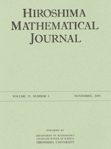
Hiroshima Mathematical Journal
Advancing Mathematical Knowledge Since 1959The Hiroshima Mathematical Journal, published by Hiroshima University, Graduate School of Science, serves as a prominent platform for disseminating high-quality research in the field of mathematics. Established in 1959, the journal has been an integral part of the mathematical community, focusing on areas such as Algebra, Number Theory, Analysis, and Geometry and Topology. Although currently classified in Q4 quartile rankings within its categories, the journal is committed to advancing mathematical knowledge and fostering scholarly dialogue. Its accessibility, combined with its long-standing history, makes it an essential resource for researchers, professionals, and students dedicated to exploring and enhancing the mathematical sciences. For those interested in contributing or accessing cutting-edge research, the Hiroshima Mathematical Journal continues to uphold its mission of excellence in mathematical scholarship.